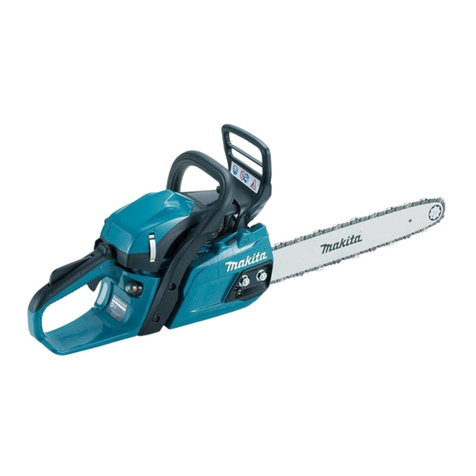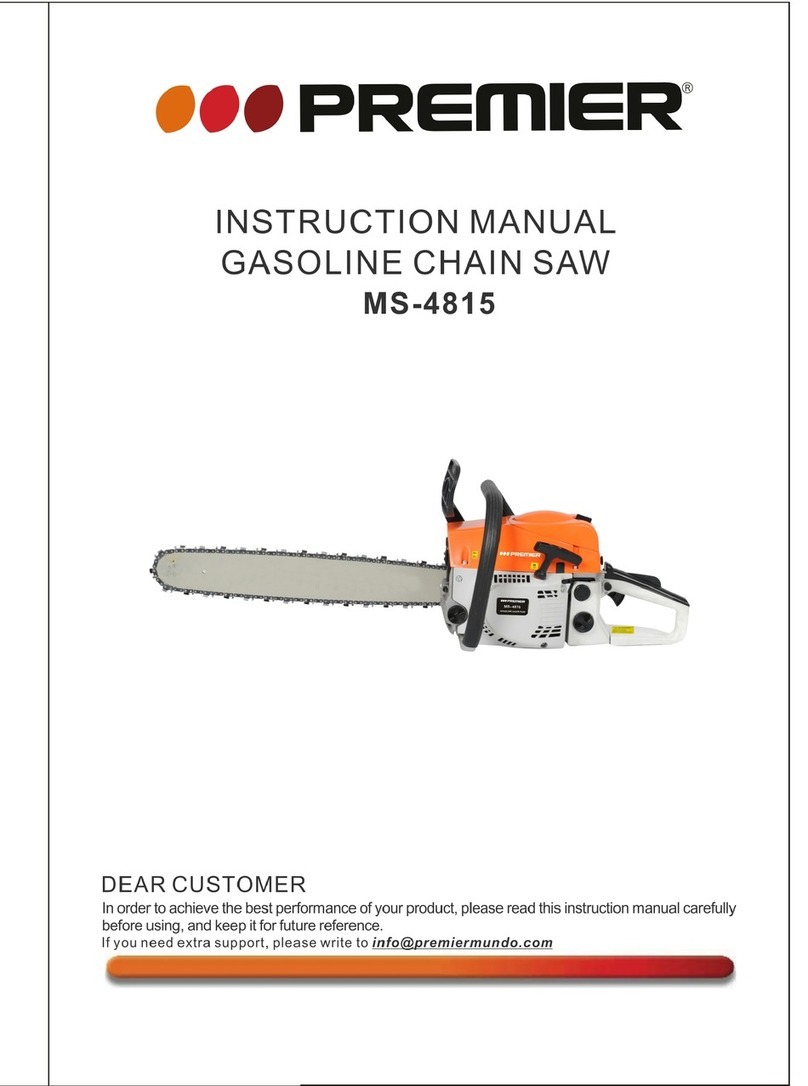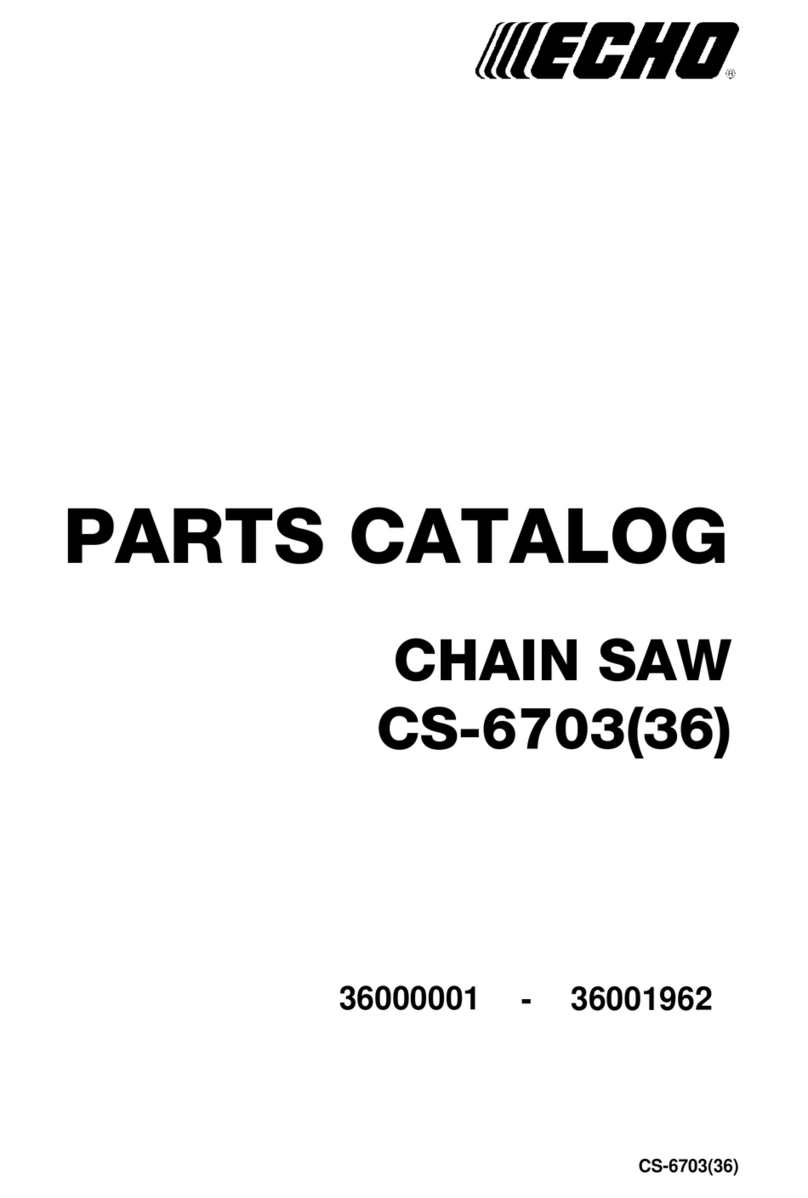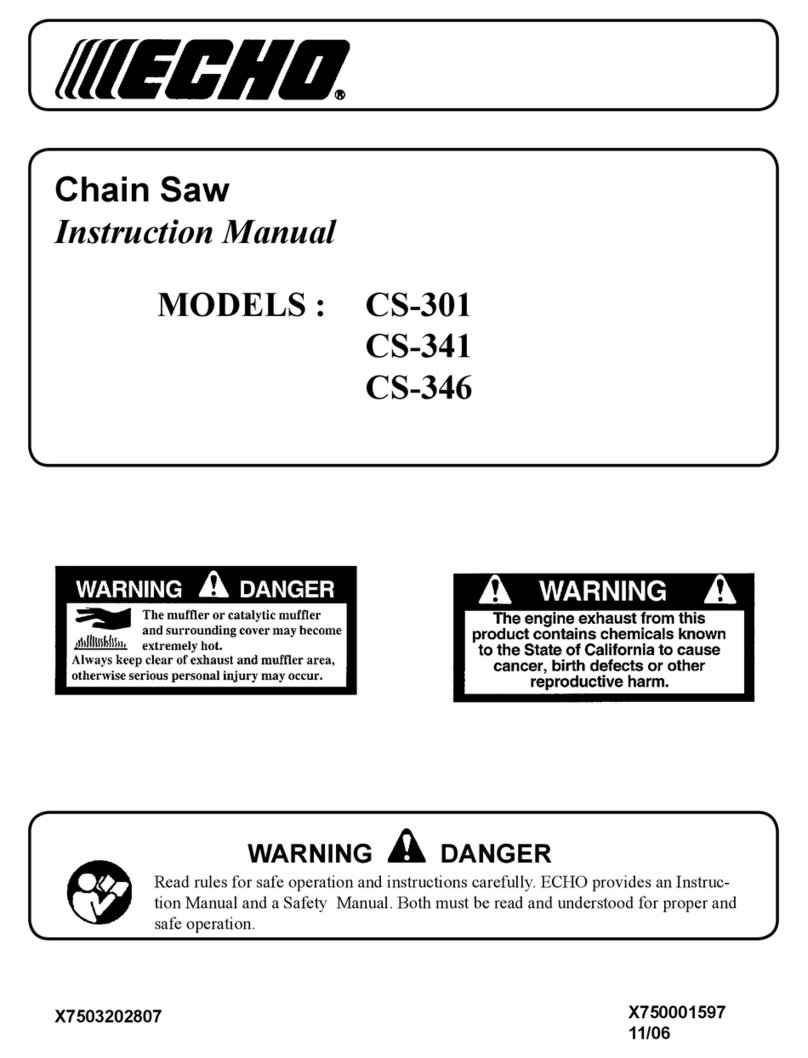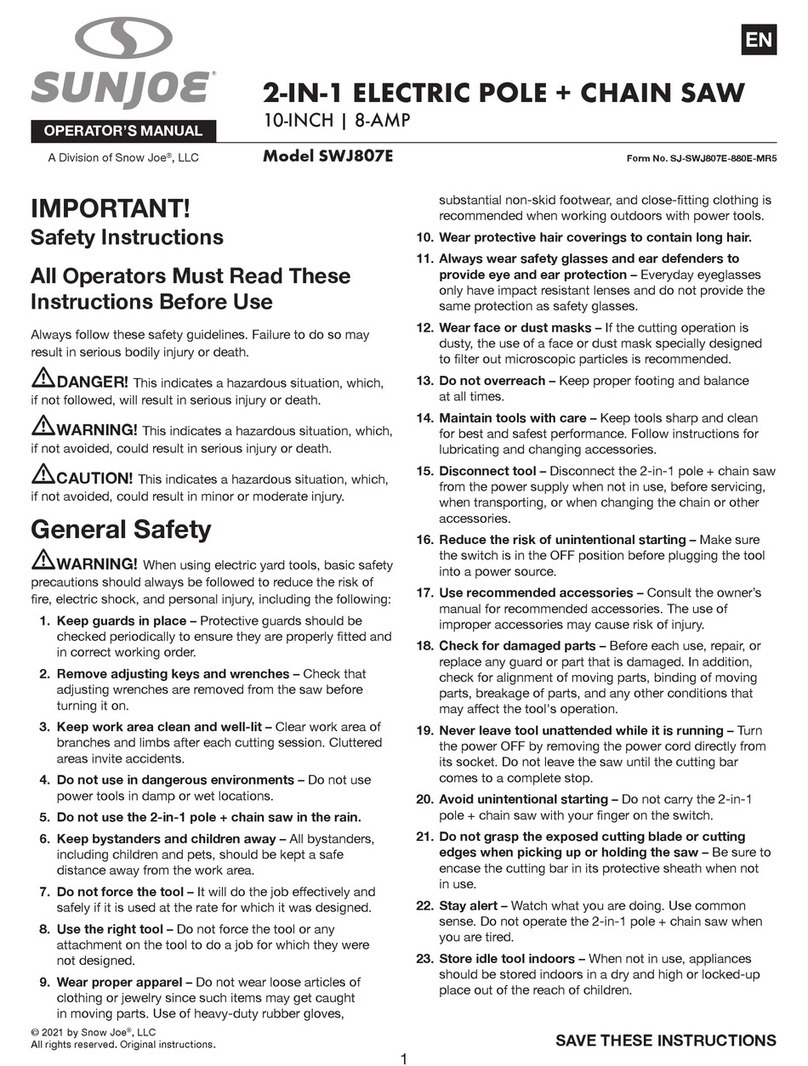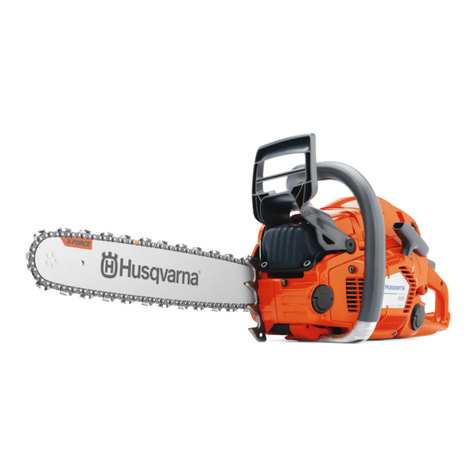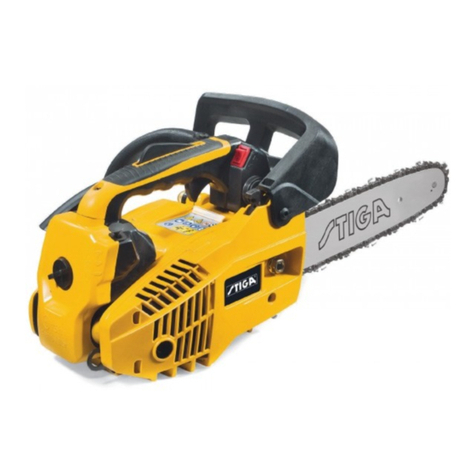Carlton N4C-BL User guide

CARLTON®| Blount, Inc.
Corporate Headquarters
P.O. Box 22127
Portland, Oregon 97269-2127 USA
carltonproducts.com
800-223-5168
©Copyright 2013 | Blount, Inc. | F/N 556740 Rev AA 3/13
Maintenance and
Safety Manual
An in-depth manual on saw chain theory,
safety, maintenance instructions and
troubleshooting for Carlton®saw chain,
guide bars and drive sprockets

If you do not have experience and specialized training for dealing with
chain saw kickback, then Carlton®urges you to use only low-kickback
saw chains which have this green label:
ATTENTION – READ THIS: The saw chain in this package
is low kickback saw chain. It met the reduced kickback
requirements of ANSI B175.1 and CSA Z62.3 when tested on a
representative sample of chain saws. Its safety features significantly
reduce the hazard of kickback while maintaining high cutting
performance. ALL CUTTING SAW CHAINS CAN KICK BACK,
which may result in severe personal injury to the chain saw operator
or bystanders. Operate your chain saw safety. Read all warnings in
your chain saw operator's manual.
Chain
pitch
Part numbers
.043"/1.1 mm
gauge
.050"/1.3 mm
gauge
.058"/1.5 mm
gauge
.063"/1.6 mm
gauge
3/8" LP N4C-BL N1C-BL — —
.325" —K1NK-BL,
K1C-BL K2C-BL K3C-BL
3/8" — A1EP-GL A2EP-GL A3EP-GL
Saw chains marked with a yellow label like the one below, are not
low-kickback and are intended for use only by professional chain saw
operators.
ATTENTION – READ THIS: Warning: this saw chain
may be capable of kickback that could result in serious injury
to the chain saw operator or bystanders. DO NOT USE THIS
SAW CHAIN UNLESS YOU HAVE EXPERIENCE AND
SPECIALIZED TRAINING FOR DEALING WITH KICKBACK.
Saw chains with reduced kickback potential are available.
Chain
pitch
Part numbers
.043"/1.1 mm
gauge
.050"/1.3 mm
gauge
.058"/1.5 mm
gauge
.063"/1.6 mm
gauge
1/4" — E1MC-BL
3/8" LP N4C N1C — —
.325" — K1C, K1L K2C, K2L K3C, K3L
3/8" — A1EP, A1LM A2EP, A2LM A3EP, A3LM
.404" — — B2EP*,
B2LM*
B3EP, B3S,
B3LM,
B3RM10,
B3H, B3H-RP
Chain Saw Safety
*Chain types to be discontinued in 2014.
Contact your authorized Carlton®distributor for availability.

Chain Saw Safety
What is kickback?
Kickback is the violent, rapid
upward and/or backward motion
of the chain saw that can occur
when the moving saw chain, near
the upper portion of the tip of
the guide bar, contacts an object
such as a log or branch, or when the wood closes in and pinches
the saw chain in the cut along the top of the guide bar.
Avoiding kickback injury
Be alert at all times to guard against a possible kickback
reaction. Always be aware of the position of your guide bar’s
nose.
Dierent models of saw chain are available for most cuing
tasks. Use the saw chain suitable for your pe of cuing with
the lowest kickback potential.
e ANSI standard* contains test methods to evaluate the
kickback potential for both chain saws and replacement saw
chain. e saw chain classication chart on the facing page is
designed to help you select appropriate replacement saw chains
in order to maintain compliance with the ANSI standard.
Carlton®packaging and labeling:
Saw chains that comply with ANSI
B175.1-2000 are identied as low-
kickback saw chain and carry the
UL Classication marking.
Chains saws and the ANSI standard
e ANSI standard divides all
gasoline powered chain saws into
o groups:
Chain saws smaller than 3.8
cubic inches (62 cc) must mt low-kickback performance
requirements in the standard (paragraph 5.11.2.1). e
manufacturer is required to mark these chain saws identiing
at least one replacement bar and chain combination that will
provide performance conrming to low-kickback requirements.
Chain saws at 3.8 cubic inches (62 cc) and above may, but
are not required to, comply with ANSI low-kickback provisions.
Chain saws that do not mt the low-kickback performance
requirements are required to be marked with a warning such as:
WARNING: is chain saw may be capable of severe
kickback that could result in serious injury to the operator
and bystanders. Do not use this chain saw unless you have
experience and specialized training for dealing with kickback. Saw
chain with reduced-kickback potential may be available.
*e ANSI standard applies to North America only.
LOW KICKBACK SAW CHAIN
IN ACCORDANCE WITH ANSI
B175.1-2000, PARAGRAPH
5.11.2.4 AND WITH
CSA Z62.3
The saw chain in this package is low
kickback saw chain. It met the reduced
kickback requirements of ANSI B175.1
when tested on a representative sample
of chain saws.Type C low-kickback saw
chain meets the kickback performance
requirements of CSA Standard Z62.3.

Chain Saw Safety
Replacement saw chain and the ANSI standard
When replacing the chain on chains saws below 3.8 cubic inch
displacement (62 cc), any low-kickback chain of the proper
pitch, gauge, and drive link count can be used. Carlton provides
replacement saw chain that is labeled in accordance with the
ANSI standard. e grn-highlighted chain pes are low
kickback. e yellow-highlighted chain pes are not low-
kickback and should only be used by those with experience and
specialized training for dealing with kickback.
Replacement guide bars and the ANSI standard
e ANSI standard states: Because of dierences in
replacement guide bars, the following guidelines shall be
considered when determining kickback energy:
A. Sprocket nose guide bars with the same eective length,
the same number of sprocket nose tth, the same nose radius,
and the same pitch may be considered to have the equivalent
kickback energy.
B. A hard-nose guide bar having the same eective bar length,
and the same or smaller nose radius as a sprocket-nose bar,
may be considered to have equivalent or less kickback energy
than the sprocket nose bar.
C. Kickback energy of all guide bars may be considered to be
less for smaller nose radius sizes.
When replacing guide bars, to maintain approximately the
same kickback energy of a chain saw, the nose size (radius)
of the replacement bar should be equal to or smaller than the
original-equipment nose – with the same bar length.

Chain Saw Safety
Recommended personal protective equipment
Dress properly–do not wear clothing that is too tight or too loose.
*These Carlton®safety clothing items are available in Europe only.
*
*
Wear a hard hat to protect
your head.
Wear ear protection to protect
your ears.
Wear safety goggles, glasses
or a face shield to protect
your eyes.
Wear gloves to prevent
slippage and to protect
your hands.
Wear chain saw protective
boots or safety boots and
gaiters to protect your feet.
Wear protective pants or
chaps to protect your legs.
*

Proper work practices
• Use a right-hand grip only to hold your chain saw; right
hand on the trigger, le hand on the ont handle. NEVER
operate with one hand!
• Kpyourlearmstraightforbeercontrol.
• Hold the chain saw rmly with both hands. Kp your
thumb rmly wrapped around the ont handle.
• Standtothesideofthechainsaw,neverbehindit.
• Runtheengineatfullthrole.
• Use a low-kickback saw chain and a reduced-kickback
guide bar whenever possible.
• Kp the chain saw, saw chain, guide bar and drive
sprocketproperlymaintained.
• Standwithyourftwellbracedandyourbodybalanced.
• Cutonlywoodwithyourchainsaw.Donotcutanyother
materials.
• Planforaclearretreatomafallingtrorbranches.
CAUTION
• Kp yourself clear of the work. Before cuing check
for hazards like tr limbs, power lines, dead trs, etc.
Calculate how the object being cut will fall. Determine
if the chain saw may be thrown unexpectedly by the
movement of the cut material. If possible, position yourself
to avoid injury, away om the natural lean of the tr.
• Nevercutaboveshoulderlevel.
• Nevercutwhileinatrorwhileonaladder.
• Kpothersaminimumofotrlengthsawayomthe
cuing area.
• Donotallowotherstoholdwoodduringcuing.
• Do not operate a chain saw when fatigued or otherwise
impaired.
• When transporting your chain saw, use the appropriate
guide bar cover.
Chain Saw Safety

Saw Chain
Introduction ................................................................................... 2
Carlton®Saw Chain Components.............................................. 3
HowSawChainCutsWood ....................................................... 6
Carlton®Saw Chain Line............................................................. 7
Carlton®Filing Specications ................................................... 10
Carlton®Maintenance Tools......................................................11
Saw Chain Maintenance............................................................ 12
Saw Chain Troubleshooting.......................................................20
Guide Bars
Carlton®Guide Bar Types.........................................................26
Guide Bar Components and Maintenance..............................29
Guide Bar Troubleshooting........................................................ 31
Drive Sprockets
Drive Sprocket Terms.................................................................32
Drive Sprocket Maintenance ....................................................33
Cuing in Cold Weather............................................................36
Contents

2Carlton®Maintenance and Safety Manual
Introduction
is manual is designed to help you obtain the full performance
and cuing eciency that was built into your Carlton®saw
chain.
e Carlton brand is dedicated to education. In our experience,
the most misunderstood part of a chain saw is the cuing
chain. We stress the importance of maintenance as a means to
promoterepeatsales;whenweteachyou,ourvaluedcustomer,
how to get the most out of our quali products, we know you’ll
buy more!
Some people believe that you nd expensive grinding
equipment and specialized training to properly maintain your
Carlton saw chain and guide bar. In fact, a few basic tools are
all you nd to maintain your saw chain and guide bar.
By reading through this handbook you will learn:
• Howthesawchainactuallycutswood.
• edierencesbenthevariouscuertoothsles.
• eproperwaytomaintainCarltonsawchaincuertth
and depth gauges.
• HowtomaintainCarltonguidebars.
• How to identi the wear paerns caused by improper
maintenance that can lead to the failure of your saw chain,
guide bar and/or drive sprocket.
If you prefer not to perform your own maintenance, all our
Authorized Carlton Dealers are trained to service all Carlton
products. A properly maintained saw chain and guide bar
makes any chain saw cut more safely and eciently.
An inventory of the component parts of saw chain is essential
to understanding how it functions. Please use page 3 to
reference the terms used in this book.

3
Carlton®Maintenance and Safety Manual
Saw Chain Components
EXPLODED VIEW OF SAW CHAIN
Guard link saw chain Bumper link saw chain
Preset
LH cutter
Preset
LH cutter Drive link
RH cutter
RH cutter
Guard
link Drive link
Plain tie strap Plain tie strap
Bumper
link
Preset LH
tie strap
Preset LH
tie strap
Cutter tooth Drive link
Tie strap Rivet
Tie strap
Rivet hubs
Flange bearing
Preset
tie strap
Carlton®Technical Tip
Saw chain parts may look alike but they are not interchangeable.
Never install used parts or mix different manufacturer’s parts
when repairing or making up saw chain loops. Always use only the
manufacturer’s replacement parts.
Clearance
angle
Top
plate
Leading
edge
Depth gauge
setting
Depth
gauge
Tang
Rivet
hole
Gullet
Toe
Heel
Side
plate
cutting
edge

4Carlton®Maintenance and Safety Manual
Saw Chain Components
Saw chain pitch
e word pitch actually means size. e larger the pitch
(measured in thousandths of an inch) the larger the saw chain.
Pitch is determined by measuring the distance ben the
centerlines of thr consecutive rivets and dividing this distance
in half. In other words, 3/8" pitch saw chain (.375") measures
3/4" (.750") ben the centerlines.
Saw chain gauge
Gauge refers to the thickness of
the drive link tangs that t into
the guide bar groove and is also
measured in thousandths of an
inch. ere are four standard
gauges for hand held chain saw
cuing chain: .043", .050", .058"
and .063". It’s essential for the
saw chain’s gauge to match the
guide bar gauge.
Carlton®Technical Tip
1. Saw chain pitch must match the pitch of the drive sprocket
and the guide bar sprocket tip.
2. Saw chain gauge must match the gauge of the guide bar.
Any mismatch of the chain saw parts will lead to premature
failure of the saw chain, guide bar, or drive sprocket.
This distance divided by 2
1.1 mm
.043"
Tang .050" 1.3 mm
.058" 1.5 mm
.063" 1.6 mm
This manual suits for next models
8
Table of contents


